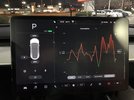lozza
Member
Battery capacity in Wh = Projected Range * Recent Avg Efficiency / SoC % (sorry quote not working for me)
Could you walk through which units you are using here? As I don't think I'm calculating my own car correctly. Will be interesting to see as I have confirmed (by Tesla) 8% loss, so should be at about 69Kwh for my 2018 P3D-
Could you walk through which units you are using here? As I don't think I'm calculating my own car correctly. Will be interesting to see as I have confirmed (by Tesla) 8% loss, so should be at about 69Kwh for my 2018 P3D-



